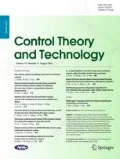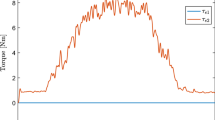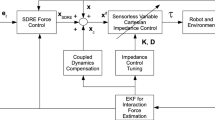Abstract
Impedance control is a well-established technique to control interaction forces in robotics. However, real implementations of impedance control with an inner loop may suffer from several limitations. In particular, the viable range of stable stiffness and damping values can be strongly affected by the bandwidth of the inner control loops (e.g., a torque loop) as well as by the filtering and sampling frequency. This paper provides an extensive analysis on how these aspects influence the stability region of impedance parameters as well as the passivity of the system. This will be supported by both simulations and experimental data. Moreover, a methodology for designing joint impedance controllers based on an inner torque loop and a positive velocity feedback loop will be presented. The goal of the velocity feedback is to increase (given the constraints to preserve stability) the bandwidth of the torque loop without the need of a complex controller.
Similar content being viewed by others
References
G. A. Pratt. Low impedance walking robots. Annual Meeting of the Society-for-Integrative-and-Comparative-Biolog, Chicago: Oxford University Press, 2002: 174–181.
J. Buchli, M. Kalakrishnan, M. Mistry, et al. Compliant quadruped locomotion over rough terrain. IEEE/RSJ International Conference on Intelligent Robots and Systems, St Louis: IEEE, 2009: 814–820.
N. Tsagarakis, S. Morfey, G. Medrano-Cerda, et al. Compliant humanoid COMAN: Optimal joint stiffness tuning for modal frequency control. IEEE International Conference on Robotics and Automation, Karlsruhe: IEEE, 2013: 673–678.
N. Paine, S. Oh, L. Sentis. Design and control considerations for high-performance series elastic actuators. IEEE/ASME Transactions on Mechatronics, 2014, 19(3): 1080–1091.
A. Albu-Schäffer, S. Haddadin, C. Ott, et al. The DLR lightweight robot: Design and control concepts for robots in human environments. Industrial Robot: An International Journal, 2007, 34(5): 376–385.
D. P. Ferris, M. Louie, C. T. Farley. Running in the real world: adjusting leg stiffness for different surfaces. Proceedings of the Royal Society B: Biological Sciences, 1998, 265(1400): 989–994.
N. Hogan. Impedance control: An approach to manipulation–Part II: Implementation. Journal of Dynamic Systems, Measurement, and Control, 1985, 107(1): 8–16.
O. Khatib. A unified approach for motion and force control of robot manipulators: The operational space formulation. Journal of Robotics and Automation. 1987: 43–53.
M. H. Raibert, J. J. Craig. Hybrid position/force control of manipulators. Journal of Dynamic Systems, Measurement, and Control, 1981, 103(2): 126–133.
J. Pratt, C. Chew, A. Torres, et al. Virtual model control: An intuitive approach for bipedal locomotion. International Journal of Robotics Research, 2001, 20(2): 129–143.
W. Bosworth, S. Kim, N. Hogan. The effect of leg impedance on stability and efficiency in quadrupedal trotting. IEEE/RSJ International Conference on Intelligent Robots and Systems, Chicago: IEEE, 2014: 4895–4900.
G. Pratt, M. Williamson. Series elastic actuators. IEEE/RSJ International Conference on Intelligent Robots and Systems, Pittsburgh: IEEE Computer Society, 1995: 399–406.
T. Boaventura, C. Semini, J. Buchli, et al. Dynamic torque control of a hydraulic quadruped robot. International Conference on Robotics and Automation, St. Paul: IEEE, 2012: 1889–1894.
M. Hutter, M. Hoepflinger, C. Gehring. Hybrid operational space control for compliant legged systems. Proceedings of Robotics: Science and Systems, Sydney: MIT Press, 2012: 150–157.
J. Mehling, J. Colgate, M. Peshkin. Increasing the impedance range of a haptic display by adding electrical damping. The 1st Joint Eurohaptics Conference and Symposium on Haptic Interfaces for Virtual Environment and Teleoperator Systems, Pisa: IEEE Computer Society, 2005: 257–262.
J. E. Colgate. Coupled stability of multiport systems–theory and experiments. Journal of Dynamic Systems, Measurement and Control, 1994, 116(3): 419–428.
G. Ellis. Control System Design Guide. 2nd ed. London: Academic Press, 2000.
F. Janabi-Sharifi, V. Hayward, C.-S. Chen. Discrete-time adaptive windowing for velocity estimation. IEEE Transactions on Control Systems Technology, 2000, 8(6): 1003–1009.
A. Albu-Schaffer, C. Ott, G. Hirzinger. A unified passivity-based control framework for position, torque and impedance control of flexible joint robots. The 12th International Journal of Robotics Research, San Francisco: SAGE Publications Ltd., 2007: 23–39.
A. Albu-Schaffer, C. Ott, G. Hirzinger. A passivity based Cartesian impedance controller for flexible joint robots–Part II: Full state feedback, impedance design and experiments. International Conference on Robotics and Automation, New Orleans: IEEE, 2004: 2666–2672.
N. Hogan, E. Colgate. Stability problems in contact tasks. Robotics Review, Cambridge: MIT Press, 2004: 339–348.
H. Karerooni, T. B. Sheridan, P. K. Houpt. Robust compliant motion for manipulators–Part I: The fundamental concepts of compliant motion, Part II: Design method. Journal of Robotics and Automation, 1986, 2(2): 83–105.
D. A. Lawrence. Impedance control stability properties in common implementations. International Conference on Robotics and Automation, Philadelphia: IEEE Computer Society, 1988: 1185–1190.
S. P. Buerger, N. Hogan. Complementary stability and loop shaping for improved human-robot interaction. IEEE Transactions on Robotics, 2007, 23(2): 232–244.
H. Mehdi, O. Boubaker. Stiffness and impedance control using Lyapunov theory for robot-aided rehabilitation. International Journal of Social Robotics, 2011, 4(1): 107–119.
N. Yasrebi, D. Constantinescu. Extending the Z-width of a haptic device using acceleration feedback. Proceedings of the 6th EuroHaptics International Conference, Madrid: Springer, 2008: 157–162.
C. Semini, N. G. Tsagarakis, E. Guglielmino, et al. Design of HyQ–a hydraulically and electrically actuated quadruped robot. Journal of Systems and Control Engineering, 2011, 225(I6): 831–849.
M. Focchi, T. Boaventura, C. Semini, et al. Torque-control based compliant actuation of a quadruped robot. Proceedings of the 12th IEEE International Workshop on Advanced Motion Control, Sarajevo: IEEE, 2012: DOI 10.1109/AMC.2012.6197133.
Y. Hori, H. Iseki, K. Sugiura. Basic consideration of vibration suppression and disturbance rejection control of multi-inertia system using SFLAC (state feedback and load acceleration control). IEEE Transactions on Industry Applications, 1994, 30(4): 889–896.
M. Focchi. Strategies to Improve the Impedance Control Performance of a Quadruped Robot. Ph.D. thesis. Italy: Istituto Italiano di Tecnologia, 2013.
T. Boaventura, M. Focchi, M. Frigerio, et al. On the role of load motion compensation in high-performance force control. IEEE/RSJ International Conference on Intelligent Robots and Systems, Algarve: IEEE, 2012: 4066–4071.
E. Colgate, N. Hogan. An analysis of contact instability in terms of passive physical equivalents. IEEE International Conference on Robotics and Automation, Scottsdale: IEEE Computer Society, 1989: 404–409.
B. D. O. Anderson, S. Vongpanitlerd. Network Analysis and Synthesis: A Modern Systems Theory Approach. New York: Dover Publications, 2006.
J. E. Colgate. The Control of Dynamically Interacting Systems. Ph.D. thesis. Cambridge: Massachusetts Institute of Technology, 1986.
J. E. Colgate, G. G. Schenkel. Passivity of a class of sampleddata systems: Application to haptic interfaces. Journal of Robotic Systems, 1997, 14(1): 37–47.
Author information
Authors and Affiliations
Corresponding author
Additional information
This work was supported by the Istituto Italiano di Tecnologia, and Dr. J. Buchli was supported by a Swiss National Science Foundation professorship.
Michele FOCCHI is currently a postdoctoral researcher at the Advanced Robotics Department of Istituto Italiano di Tecnologia. He received both the B.Sc. and the M.Sc. in Control System Engineering from Politecnico di Milano in 2004 and 2007, respectively. Until 2009 he worked for the R&D Department of Indesit Company. In 2009 he joined the Advanced Robotic Department (ADVR) at Istituto Italiano di Tecnologia, (Genova, Italy) developing a prototype of a novel concept of air-pressure driven microturbine for power generation for which he obtained an international patent and several awards. In 2013 he obtained a Ph.D. degree in Robotics, getting involved in the Hydraulically Actuated Quadruped Robot project where he developing low-level controllers for locomotion purposes. Currently, his research interests range from planning of dynamic motions to whole body control.
Gustavo A. MEDRANO-CERDA received the B.Sc. degree in Electro-mechanical Engineering from the Universidad Nacional Autonoma de Mexico in 1977, and the M.Sc. and Ph.D. degrees in Control Systems from Imperial College, London, in 1979 and 1982, respectively. From 1982 to 1985 he was an associate professor at the Division de Estudios de Postgrado, Facultad de Ingenieria, Universidad Nacional Autonoma de Mexico. From 1985 to 1986 he was a research fellow at the Department of Engineering, University of Warwick. From 1986 to 2002 he was a lecturer at the Department of Electronic and Electrical Engineering at the University of Salford. During this period he set up the Advanced control and robot locomotion laboratory at the University of Salford. In 1999 he became a control systems consultant at Las Cumbres Observatory (formerly Telescope Technologies Ltd.) and later in 2002 he joined the company as a senior control engineer pioneering work in H-infinity control system design and implementation for astronomical telescopes. Since 2009 he has been a senior research scientist at the Advanced Robotics Department, Istituto Italiano di Tecnologia. His research interests are in the areas of robust control, adaptive control, modelling and identification, fuzzy systems and advanced robotic applications, in particular to walking robots.
Thiago BOAVENTURA received his B.Sc. and M.Sc. degrees in Mechatronic Engineering from Federal University of Santa Catarina, Florianopolis, Brazil, in 2009 and the Ph.D. degree in Robotics, Cognition, and Interaction Technologies from a partnership between Istituto Italiano di Tecnologia and University of Genoa, Genova, Italy, in 2013. He is a postdoctoral researcher with Agile and Dexterous Robotics Laboratory, ETH Zurich, Zurich, Switzerland. He is mainly involved in the EU FP7 BALANCE project with a focus in the collaborative impedance control of exoskeletons. His research interests include impedance and admittance control, model-based control, legged robotics, optimal and learning control, and wearable robotics.
Marco FRIGERIO received his B.Sc. and M.Sc. degrees in Computer Science from the University of Milano Bicocca, respectively in 2006 and 2008, and the Ph.D. degree in Robotics from the Istituto Italiano di Tecnologia (IIT) in 2013. He is currently a postdoctoral researcher at the Dynamic Legged Systems Lab of IIT, where he is involved in the development of hydraulic legged robots. His research interests include software for robotics, software architectures, kinematics and dynamics of mechanisms.
Claudio SEMINI is the head of the Dynamic Legged Systems Lab of the Department of Advanced Robotics at Istituto Italiano di Tecnologia (IIT). He holds an M.Sc. degree from ETH Zurich in Electrical Engineering and Information Technology (2005). From 2004 to 2006 he first visited the Hirose Lab at the Tokyo Institute of Technology, followed by work on mobile service robotics at the Toshiba R&D center in Kawasaki, Japan. During his doctorate from 2007-2010 at the IIT he designed and constructed the quadruped robot HyQ and worked on its control. After a postdoctoral research in the same department, in 2012, he became the head of the Dynamic Legged Systems Lab. His research focus lies on the construction and control of highly dynamic and versatile legged robots in real-world environments.
Jonas BUCHLI received the Diploma degree in Electrical Engineering from ETH Zurich, Zurich, Switzerland, in 2003 and the Ph.D. degree from Ecole Polytechnique Federale de Lausanne, Lausanne, Switzerland, in 2007. From 2007 to 2010, he was a postdoctoral researcher with the Computational Learning and Motor Control Laboratory, University of Southern California (USC), where he was the Team Leader of the USC Team for the DARPA Learning Locomotion challenge. From 2010 to 2012, he was a team leader with the Advanced Robotics Department, Istituto Italiano di Tecnologia, Genova, Italy. He is currently an assistant professor with the Institute of Robotics and Intelligent Systems, ETH Zurich, Zurich, Switzerland, and the Director of the Agile and Dexterous Robotics Lab. Dr. Buchli has received a Prospective and an Advanced Researcher Fellowship from the Swiss National Science Foundation (SNF). In 2012, he received a Professorship Award from the SNF.
Darwin G. CALDWELL received the B.Sc. and Ph.D. degrees in Robotics from University of Hull, Hull, U.K., in 1986 and 1990, respectively, and the M.Sc. degree in Management from University of Salford, Salford, U.K., in 1996. He is the Director of Robotics with Istituto Italiano di Tecnologia, Genova, Italy. He is a Visiting/ Honorary/Emeritus Professor with University of Sheffield, the University of Manchester, and University of Wales, Bangor. His research interests include innovative actuators and sensors, haptic feedback, force augmentation exoskeletons, dexterous manipulators, humanoid robotics, biomimetic systems, rehabilitation robotics, and telepresence and teleoperation procedures.
Rights and permissions
About this article
Cite this article
Focchi, M., Medrano-Cerda, G.A., Boaventura, T. et al. Robot impedance control and passivity analysis with inner torque and velocity feedback loops. Control Theory Technol. 14, 97–112 (2016). https://doi.org/10.1007/s11768-016-5015-z
Received:
Revised:
Accepted:
Published:
Issue Date:
DOI: https://doi.org/10.1007/s11768-016-5015-z




